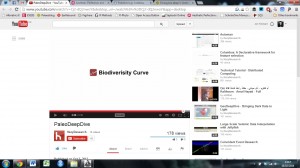Last night, I was honoured to have spoken at the final evening lecture at the Cambridge Science Festival, along with Nick Crumpton, Anjali Goswami, Rob Asher, and Stephanie Pierce, about why palaeontology is important. Below is a rough transcript of some of what my talk was about. Unlike the others, I didn’t discuss my own research. Instead, by general gist was that although palaeontology is useful in addressing some of the greatest scientific questions of our time, like the evolution and history of life on Earth, the current narrow framing of science in terms of impact is being quite detrimental to creativity and exploratory science. As such, should palaeontology be more focused on its emotive qualities, and be used as a ‘hook’, or ‘gateway’ into the other fields of science?
Diving too deep?
A new initiative has just been announced that could help to revolutionise palaeontology. PaleoDeepDive is essentially an automated version of the Paleobiology Database, which is an online, professionally crowd-sourced and curated database of fossil occurrences pulled from the literature.
They have a launch video here:
I have a couple of reservations about this. Firstly, how do they expect to mine data from articles that are mostly still locked behind paywalls, at least legally.
I’m also a little concerned about the precision of their algorithms. Towards the end, they mention that in a sample of 500 articles, they get 15000 species names, whereas the PaleobioDB only picks up 1100. Well, in the latter, these names are occurrences – explicit records of fossils in time and space. What these 15000 represent is not clear – are they just those that are mentioned in the text, and therefore don’t really have any use, or are all the palaeontologists really just missing out on 90% of the data when extracting manually?
Additionally, I am concerned about the linking of metadata, such as the location and age of fossils, as well as data about the geology, environment of deposition, taphonomy etc. All of this information has to be sifted out of articles from within a host of information in articles when extraction is manual. I’m not sure if a machine will be able to distinguish between, for example, geological dates from something related, but not directly the age of the fossil, in text.
Anyway, these are just preliminary thoughts, and am sure that they have crossed the developers’ minds at some point, I look forward to seeing how this progresses, and undermines a lot of my work! 😉
Also, I’d love to hear any thoughts or comments you have about it!
In which we explain how camel ankle bones relate to the fate of global ecosystems.
This was originally posted at 4th Dimensional Biology by Brianna McHorse and Edward Davis. Reblogging because awesome (with permission).
I’m taking time away from comic book blogging to do some actual SCIENCE BLOGGING. Just last month I published a paper in Palaeontologia Electronica with my esteemed colleague Brianna McHorse (who blogs over at Fossilosophy). It’s called “A method for improved identification of postcrania from mammalian fossil assemblages: multivariate discriminant function analysis of camelid astragali.” In this paper, we work with fossilized camel ankle bones from theThousand Creek of Nevada that are about 8 million years old. Here’s the plain-language abstract for those who don’t speak paleontology. Brianna and I have coauthored this blog post to share the wonders of these ankle bones with a broader audience.
Was the diversity of feeding styles in giant turtles a key to their suckcess?
Sometimes, it can be difficult to figure out how ancient organisms used to eat. Part of the problem is that we can never actually see extinct animals eating (until we invent time-travel.. *taps fingers impatiently at physicists*), and often it can be hard to work out how something ate based just on its anatomy. Sometimes though, the fossil record chucks up something truly spectacular, and gives us amazing insight into the spectacular diversity of ancient life.
Let’s roll it back a bit.

